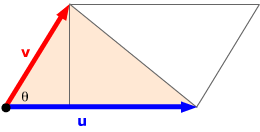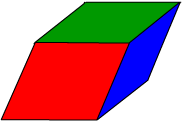The area of the parallelogram in 3-space with sides u and v is
|u x v| .
The area of the triangle in 3-space with sides u and v is
(1/2) |u x v| .
Proof: The area of the parallelogram is its base times its height. Its base is |u|, its height is |v|sin θ, so its area is |u||v|sin θ = |u x v| . |
 |
The area of the triangle is half that of the parallelogram, or (1/2)|u x v|. |
 |





 .
. .
.